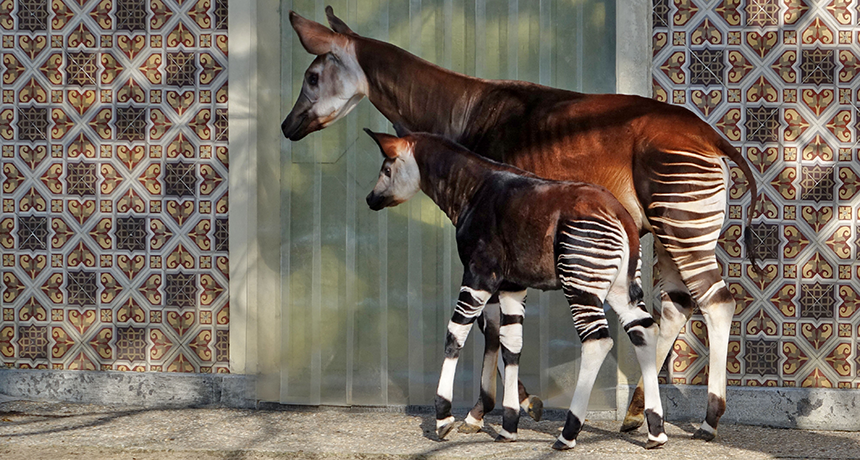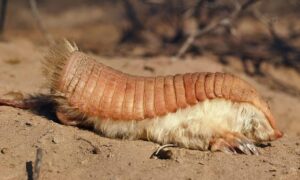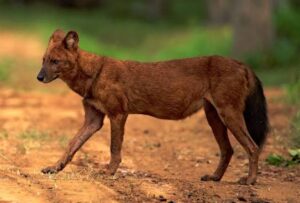Introduction
Imagine venturing deep into the rainforests of Central Africa, where the dense canopy filters sunlight into a mosaic of shifting greens and shadows. Hidden within this mysterious landscape lives a creature so elusive that for centuries it was considered almost mythical. With striped hindquarters reminiscent of a zebra, a body shape similar to a horse, and a long neck and tongue that reveal its kinship to giraffes, the okapi (Okapia johnstoni) is one of the most unique and fascinating mammals alive today.
Often nicknamed the “forest giraffe” or the “African unicorn,” the okapi perfectly illustrates how evolution can produce animals that defy easy categorization. Though it was unknown to Western science until the early 20th century, local Congolese communities had long known of its existence. Today, the okapi stands as a living reminder of the diversity of African wildlife, as well as a symbol of the fragile balance between nature and human activity.
This article explores the okapi’s appearance, evolutionary background, behavior, ecology, and cultural significance. By peeling back the layers of mystery surrounding this elusive creature, we gain not only an appreciation for its biology but also a deeper understanding of the forests it calls home.
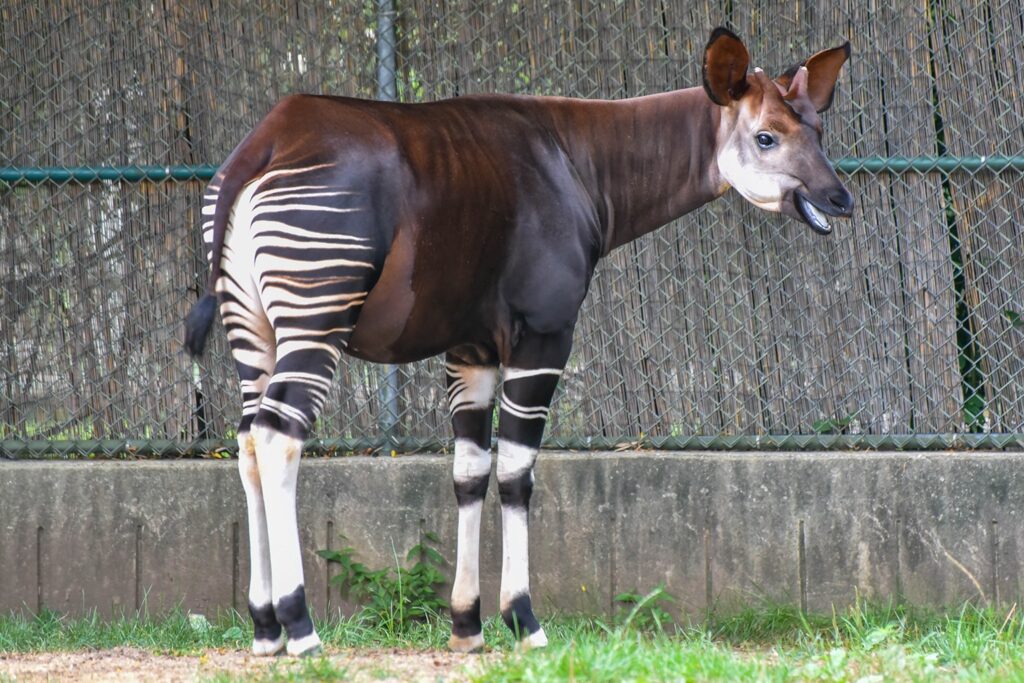
The Name and the First Mystery
The okapi owes its scientific name, Okapia johnstoni, to two sources. “Okapia” is derived from the word o’api, used by the Lese people of the Democratic Republic of the Congo (DRC) to describe the animal. The species name, johnstoni, honors Sir Harry Johnston, a British explorer who played a central role in bringing the animal to the attention of Western science in 1901.
Before Johnston’s discovery, rumors of a mysterious striped forest animal had circulated among European explorers. Some described it as a “forest horse,” others thought it was a kind of zebra, while a few speculated it might even be related to donkeys or antelopes. The Congolese people, however, had long recognized the okapi as part of their natural world.
When specimens were finally sent to European zoologists, they were astonished to learn that the okapi was not a horse, zebra, or antelope—but instead the closest living relative of the giraffe. This revelation overturned earlier assumptions and added an entirely new branch to the giraffe family tree.
Size and Physical Description
The okapi is a medium-sized ungulate with a body length of around 2 meters (6.5 feet), a shoulder height of about 1.5 meters (5 feet), and a weight ranging from 200 to 350 kilograms (440–770 pounds). Its most striking feature is its contrasting coat: a rich, chocolate-brown or reddish torso, with bold horizontal white stripes on its legs and hindquarters. These stripes, which resemble those of a zebra, provide excellent camouflage in the dappled light of the forest.
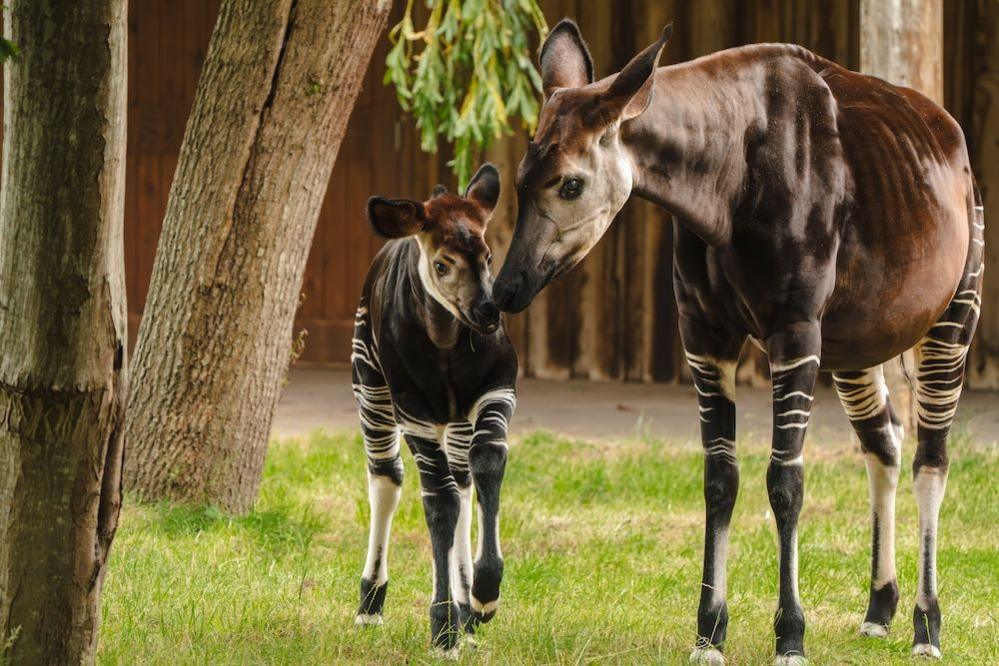
The okapi’s head resembles that of a giraffe, with large, upright ears that can swivel independently to detect sounds from all directions. Its neck, while not as elongated as a giraffe’s, is longer than most forest mammals, giving it access to mid-level foliage. Its tongue is one of its most extraordinary adaptations: a prehensile, bluish-black organ that can extend up to 35 centimeters (14 inches). With it, the okapi can skillfully pluck leaves, strip buds, and even groom itself by cleaning its eyes and ears.
Males possess small, skin-covered ossicones (horn-like structures), while females do not. Both sexes exhibit the same striping patterns, although no two individuals are exactly alike—much like a fingerprint.
Skin, Coat, and Adaptations
The okapi’s velvety fur is thick and oily, designed to repel moisture in the rainforest environment. This water-resistant quality helps it survive in the wet climate of the Ituri Forest, where rain is frequent and heavy. The stripes on its legs and hindquarters not only serve as camouflage but also act as visual signals for calves, which follow their mothers through the dense undergrowth by recognizing these distinctive markings.
The dark coloration of its coat helps it blend into the forest shadows, making it extremely difficult to spot. In fact, the okapi’s ability to disappear into the foliage is so effective that even experienced trackers can walk within a few meters of one without noticing.
Classification and Evolutionary Puzzle
The okapi belongs to the family Giraffidae, which includes only two living species: the giraffe (Giraffa camelopardalis) and the okapi (Okapia johnstoni). Fossil evidence shows that giraffids were once far more diverse, with multiple species spread across Africa and Eurasia.
The evolutionary split between giraffes and okapis likely occurred around 11–12 million years ago. While giraffes adapted to open savannas with long necks and tall browsing abilities, the okapi remained in the dense Central African forests, retaining a shorter neck and cryptic coloration better suited to woodland survival.
This evolutionary divergence makes the okapi a living relic—a reminder of an ancient branch of ungulates that largely vanished elsewhere. Its existence highlights how different ecological pressures can shape close relatives into radically different forms.
Lifestyle and Behavior
The okapi is primarily solitary, with males and females occupying overlapping but distinct home ranges. They communicate through scent-marking using glands on their feet and through low-frequency vocalizations that are inaudible to humans. Mothers and calves maintain close bonds, but adults typically avoid each other except during mating season.
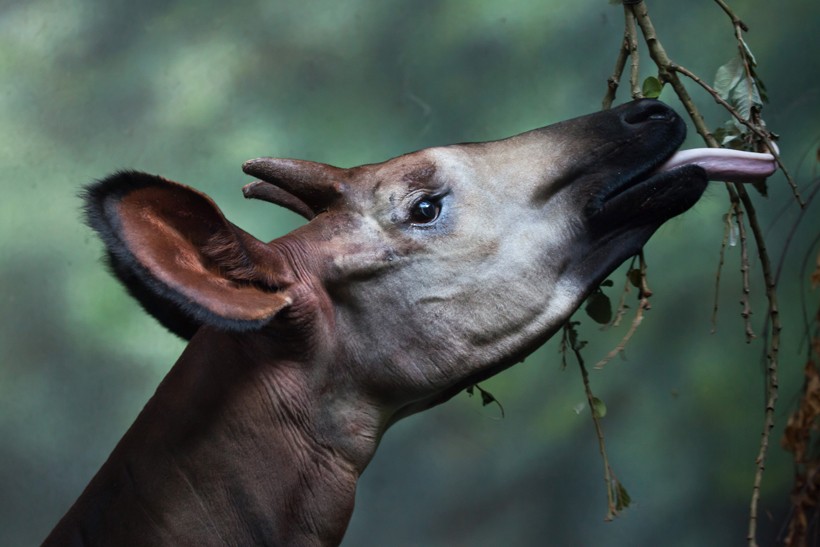
Okapis are diurnal, meaning they are most active during the day. Their keen sense of hearing helps them detect predators, which in the Congo rainforest include leopards and occasionally humans.
Feeding and Diet
Okapis are strict herbivores, feeding on leaves, buds, shoots, fruits, and fungi. They consume over 100 different plant species, some of which are toxic to humans. Their prehensile tongue is their primary feeding tool, capable of reaching and stripping foliage with incredible precision.
Reproduction
Breeding can occur throughout the year, although peaks are often linked to seasonal plant availability. After a gestation period of about 14–16 months, females give birth to a single calf. Unlike many ungulates, okapi calves spend much of their first two months lying hidden in vegetation, minimizing movement to avoid predators. Mothers return periodically to nurse and groom their young. This “hider strategy” is a remarkable adaptation to life in the dense forest.
The Ecosystem: Congo’s Ituri Rainforest
The okapi is endemic to the Ituri Rainforest in the northeastern Democratic Republic of the Congo. This dense tropical forest is one of the most biodiverse ecosystems in the world, home to primates, forest elephants, bongos, and countless bird and insect species.
In this environment, the okapi plays a crucial role as a browser, shaping the growth of understory vegetation. By feeding on certain plants, it influences plant community dynamics and provides pathways through the dense forest that other animals may use.
However, the okapi’s reliance on this ecosystem also makes it extremely vulnerable to deforestation, mining, and human settlement.
Threats and Conservation Status
The okapi is currently classified as Endangered by the International Union for Conservation of Nature (IUCN). Its population has declined by more than 50% in recent decades due to:
- Deforestation: Logging and mining destroy critical rainforest habitat.
- Poaching: Okapis are hunted for bushmeat and skins.
- Political Instability: Armed groups in the DRC contribute to habitat destruction and make conservation difficult.
- Disease and Predators: Natural threats include leopards, but human-driven threats are far greater.
To protect the species, the Okapi Wildlife Reserve was established in 1992, covering approximately 13,700 square kilometers of the Ituri Forest. This UNESCO World Heritage Site provides sanctuary for an estimated 5,000 okapis. Despite challenges, it remains the cornerstone of okapi conservation.
Cultural Significance and Human Connection
For the Congolese people, the okapi is more than just a forest animal—it is a symbol of national pride and natural heritage. In fact, the okapi is the national symbol of the Democratic Republic of the Congo and even appears on its banknotes and official emblems.
In Western culture, the okapi’s discovery in the early 20th century fascinated zoologists and the public alike. It was often compared to the legendary unicorn due to its elusive nature and unique appearance. Today, it continues to inspire wonder in zoos and documentaries around the world.
Summary: Facts at a Glance
| Attribute | Details |
|---|---|
| Name | Okapia johnstoni |
| Meaning | Named after explorer Sir Harry Johnston |
| Length | 2 meters (6.5 feet) |
| Height | 1.5 meters (5 feet) at shoulder |
| Weight | 200–350 kg (440–770 lbs) |
| Diet | Herbivorous (leaves, buds, fruits, fungi) |
| Lifespan | 20–30 years (in captivity, slightly less in wild) |
| Reproduction | 14–16 month gestation; single calf |
| Habitat | Ituri Rainforest, Democratic Republic of the Congo |
| Status | Endangered |
| Closest Relative | Giraffe |
Final Thoughts
The okapi is a living paradox—an animal that looks like a mixture of zebra, horse, and giraffe, yet is none of these things. Its elusive nature and secretive lifestyle have made it one of the least understood large mammals on Earth, but also one of the most captivating.
As the okapi’s rainforest home faces increasing pressure from human activities, protecting this species becomes not just about saving a single animal, but about preserving one of the most diverse ecosystems on the planet.
Much like the Therizinosaurus of the Cretaceous period, the okapi teaches us that evolution often produces creatures that defy expectations. By safeguarding this forest giraffe, we safeguard a unique chapter of life’s story—one that bridges the ancient and modern worlds of mammals.
Okapi: The Secretive Forest Giraffe
Introduction
Imagine venturing deep into the rainforests of Central Africa, where the dense canopy filters sunlight into a mosaic of shifting greens and shadows. Hidden within this mysterious landscape lives a creature so elusive that for centuries it was considered almost mythical. With striped hindquarters reminiscent of a zebra, a body shape similar to a horse, and a long neck and tongue that reveal its kinship to giraffes, the okapi (Okapia johnstoni) is one of the most unique and fascinating mammals alive today.
Often nicknamed the “forest giraffe” or the “African unicorn,” the okapi perfectly illustrates how evolution can produce animals that defy easy categorization. Though it was unknown to Western science until the early 20th century, local Congolese communities had long known of its existence. Today, the okapi stands as a living reminder of the diversity of African wildlife, as well as a symbol of the fragile balance between nature and human activity.
This article explores the okapi’s appearance, evolutionary background, behavior, ecology, and cultural significance. By peeling back the layers of mystery surrounding this elusive creature, we gain not only an appreciation for its biology but also a deeper understanding of the forests it calls home.
The Name and the First Mystery
The okapi owes its scientific name, Okapia johnstoni, to two sources. “Okapia” is derived from the word o’api, used by the Lese people of the Democratic Republic of the Congo (DRC) to describe the animal. The species name, johnstoni, honors Sir Harry Johnston, a British explorer who played a central role in bringing the animal to the attention of Western science in 1901.
Before Johnston’s discovery, rumors of a mysterious striped forest animal had circulated among European explorers. Some described it as a “forest horse,” others thought it was a kind of zebra, while a few speculated it might even be related to donkeys or antelopes. The Congolese people, however, had long recognized the okapi as part of their natural world.
When specimens were finally sent to European zoologists, they were astonished to learn that the okapi was not a horse, zebra, or antelope—but instead the closest living relative of the giraffe. This revelation overturned earlier assumptions and added an entirely new branch to the giraffe family tree.
Size and Physical Description
The okapi is a medium-sized ungulate with a body length of around 2 meters (6.5 feet), a shoulder height of about 1.5 meters (5 feet), and a weight ranging from 200 to 350 kilograms (440–770 pounds). Its most striking feature is its contrasting coat: a rich, chocolate-brown or reddish torso, with bold horizontal white stripes on its legs and hindquarters. These stripes, which resemble those of a zebra, provide excellent camouflage in the dappled light of the forest.
The okapi’s head resembles that of a giraffe, with large, upright ears that can swivel independently to detect sounds from all directions. Its neck, while not as elongated as a giraffe’s, is longer than most forest mammals, giving it access to mid-level foliage. Its tongue is one of its most extraordinary adaptations: a prehensile, bluish-black organ that can extend up to 35 centimeters (14 inches). With it, the okapi can skillfully pluck leaves, strip buds, and even groom itself by cleaning its eyes and ears.
Males possess small, skin-covered ossicones (horn-like structures), while females do not. Both sexes exhibit the same striping patterns, although no two individuals are exactly alike—much like a fingerprint.
Skin, Coat, and Adaptations
The okapi’s velvety fur is thick and oily, designed to repel moisture in the rainforest environment. This water-resistant quality helps it survive in the wet climate of the Ituri Forest, where rain is frequent and heavy. The stripes on its legs and hindquarters not only serve as camouflage but also act as visual signals for calves, which follow their mothers through the dense undergrowth by recognizing these distinctive markings.
The dark coloration of its coat helps it blend into the forest shadows, making it extremely difficult to spot. In fact, the okapi’s ability to disappear into the foliage is so effective that even experienced trackers can walk within a few meters of one without noticing.
Classification and Evolutionary Puzzle
The okapi belongs to the family Giraffidae, which includes only two living species: the giraffe (Giraffa camelopardalis) and the okapi (Okapia johnstoni). Fossil evidence shows that giraffids were once far more diverse, with multiple species spread across Africa and Eurasia.
The evolutionary split between giraffes and okapis likely occurred around 11–12 million years ago. While giraffes adapted to open savannas with long necks and tall browsing abilities, the okapi remained in the dense Central African forests, retaining a shorter neck and cryptic coloration better suited to woodland survival.
This evolutionary divergence makes the okapi a living relic—a reminder of an ancient branch of ungulates that largely vanished elsewhere. Its existence highlights how different ecological pressures can shape close relatives into radically different forms.
Lifestyle and Behavior
The okapi is primarily solitary, with males and females occupying overlapping but distinct home ranges. They communicate through scent-marking using glands on their feet and through low-frequency vocalizations that are inaudible to humans. Mothers and calves maintain close bonds, but adults typically avoid each other except during mating season.
Okapis are diurnal, meaning they are most active during the day. Their keen sense of hearing helps them detect predators, which in the Congo rainforest include leopards and occasionally humans.
Feeding and Diet
Okapis are strict herbivores, feeding on leaves, buds, shoots, fruits, and fungi. They consume over 100 different plant species, some of which are toxic to humans. Their prehensile tongue is their primary feeding tool, capable of reaching and stripping foliage with incredible precision.
Reproduction
Breeding can occur throughout the year, although peaks are often linked to seasonal plant availability. After a gestation period of about 14–16 months, females give birth to a single calf. Unlike many ungulates, okapi calves spend much of their first two months lying hidden in vegetation, minimizing movement to avoid predators. Mothers return periodically to nurse and groom their young. This “hider strategy” is a remarkable adaptation to life in the dense forest.
The Ecosystem: Congo’s Ituri Rainforest
The okapi is endemic to the Ituri Rainforest in the northeastern Democratic Republic of the Congo. This dense tropical forest is one of the most biodiverse ecosystems in the world, home to primates, forest elephants, bongos, and countless bird and insect species.
In this environment, the okapi plays a crucial role as a browser, shaping the growth of understory vegetation. By feeding on certain plants, it influences plant community dynamics and provides pathways through the dense forest that other animals may use.
However, the okapi’s reliance on this ecosystem also makes it extremely vulnerable to deforestation, mining, and human settlement.
Threats and Conservation Status
The okapi is currently classified as Endangered by the International Union for Conservation of Nature (IUCN). Its population has declined by more than 50% in recent decades due to:
- Deforestation: Logging and mining destroy critical rainforest habitat.
- Poaching: Okapis are hunted for bushmeat and skins.
- Political Instability: Armed groups in the DRC contribute to habitat destruction and make conservation difficult.
- Disease and Predators: Natural threats include leopards, but human-driven threats are far greater.
To protect the species, the Okapi Wildlife Reserve was established in 1992, covering approximately 13,700 square kilometers of the Ituri Forest. This UNESCO World Heritage Site provides sanctuary for an estimated 5,000 okapis. Despite challenges, it remains the cornerstone of okapi conservation.
Cultural Significance and Human Connection
For the Congolese people, the okapi is more than just a forest animal—it is a symbol of national pride and natural heritage. In fact, the okapi is the national symbol of the Democratic Republic of the Congo and even appears on its banknotes and official emblems.
In Western culture, the okapi’s discovery in the early 20th century fascinated zoologists and the public alike. It was often compared to the legendary unicorn due to its elusive nature and unique appearance. Today, it continues to inspire wonder in zoos and documentaries around the world.
Summary: Facts at a Glance
| Attribute | Details |
|---|---|
| Name | Okapia johnstoni |
| Meaning | Named after explorer Sir Harry Johnston |
| Length | 2 meters (6.5 feet) |
| Height | 1.5 meters (5 feet) at shoulder |
| Weight | 200–350 kg (440–770 lbs) |
| Diet | Herbivorous (leaves, buds, fruits, fungi) |
| Lifespan | 20–30 years (in captivity, slightly less in wild) |
| Reproduction | 14–16 month gestation; single calf |
| Habitat | Ituri Rainforest, Democratic Republic of the Congo |
| Status | Endangered |
| Closest Relative | Giraffe |
Final Thoughts
The okapi is a living paradox—an animal that looks like a mixture of zebra, horse, and giraffe, yet is none of these things. Its elusive nature and secretive lifestyle have made it one of the least understood large mammals on Earth, but also one of the most captivating.
As the okapi’s rainforest home faces increasing pressure from human activities, protecting this species becomes not just about saving a single animal, but about preserving one of the most diverse ecosystems on the planet.
Much like the Therizinosaurus of the Cretaceous period, the okapi teaches us that evolution often produces creatures that defy expectations. By safeguarding this forest giraffe, we safeguard a unique chapter of life’s story—one that bridges the ancient and modern worlds of mammals.

